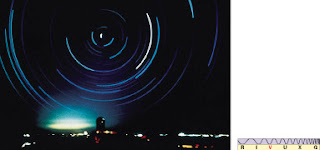The "Obvious" View
How have we come to know the universe around us? How do we know the proper perspective sketched in Figure 1.5? Let’s start with some very basic observations. Our study of the universe, the modern science of astronomy, begins simply by looking at the night sky.
CONSTELLATIONS IN THE SKY
Between sunset and sunrise on a clear night we can see about 3000 points of light. If we include the view from the opposite side of Earth, nearly 6000 stars are visible to the unaided eye. A natural human tendency is to see patterns and relationships between objects even when no true connection exists, and people long ago connected the brightest stars into configurations called constellations, which ancient astronomers named after mythological beings, heroes, and animals—whatever was important to them. Figure 1.6 shows a constellation especially prominent in the nighttime sky from October through March: the hunter named Orion. Orion was a mythical Greek hero famed, among other things, for his amorous pursuit of the Pleiades, the seven daughters of the giant Atlas. According to Greek mythology, to protect the Pleiades from Orion, the gods placed them among the stars, where Orion nightly stalks them across the sky. Many constellations have similarly fabulous connections with ancient lore.
Perhaps not surprisingly, the patterns have a strong cultural bias—the astronomers of ancient China saw mythical figures different from those seen by the ancient Greeks, the Babylonians, and the people of other cultures, even though they were all looking at the same stars in the night sky. Interestingly, different cultures often made the same basic groupings of stars, despite widely varying interpretations of what they saw. For example, the group of seven stars usually known in North America as "the Dipper" is known as "the Wagon" or "the Plough" in western Europe. The ancient Greeks regarded these same stars as the tail of "the Great Bear," the Egyptians saw them as the leg of an ox, the Siberians as a stag, and some Native Americans as a funeral procession.
Early astronomers had very practical reasons for studying the sky. Some constellations served as navigational guides. The star Polaris (part of the Little Dipper) indicates north, and the near-constancy of its location in the sky, from hour to hour and night to night, has aided travelers for centuries. Other constellations served as primitive calendars to predict planting and harvesting seasons. For example, many cultures knew that the appearance of certain stars on the horizon just before daybreak signaled the beginning of spring and the end of winter.
In many societies, people came to believe that there were other benefits in being able to trace the regularly changing positions of heavenly bodies. The relative positions of stars and planets at a person’s birth were carefully studied byastrologers, who used the data to make predictions about that person’s destiny. Thus, in a sense, astronomy and astrology arose from the same basic impulse—the desire to "see" into the future—and, indeed, for a long time they were indistinguishable from one another. Today most people recognize that astrology is nothing more than an amusing diversion. (Although millions still study their horoscope in the newspaper every morning!) Nevertheless, the ancient astrological terminology—the names of the constellations and many tems used to describe the locations and motions of the planets—is still used throughout the astronomical world.
Generally speaking, as illustrated in Figure 1.6(c) for the case of Orion, the stars that make up any particular constellation are not actually close to one another in space, even by astronomical standards. They merely are bright enough to observe with the naked eye and happen to lie in roughly the same direction in the sky as seen from Earth. Still, the constellations provide a convenient means for astronomers to specify large areas of the sky, much as geologists use continents, or politicians use voting precincts to identify certain localities on planet Earth. In all, there are 88 constellations, most of them visible from North America at some time during the year. Figure 1.7 shows how the conventionally defined constellations cover a portion of the sky in the vicinity of Orion.
From our modern standpoint, the apparent motion of the stars is the result of the spin, or rotation, not of the celestial sphere but of Earth. Polaris indicates the direction—due north—in which Earth’s rotation axis points. Even though we now know that the celestial sphere is an incorrect description of the heavens, we still use the idea as a convenient fiction that helps us visualize the positions of stars in the sky. The points where Earth’s axis intersects the celestial sphere are called the celestial poles. In the Northern Hemisphere, the north celestial pole lies directly above Earth’s North Pole. The extension of Earth’s axis in the opposite direction defines the south celestial pole, directly above Earth’s South Pole. Midway between the north and south celestial poles lies the celestial equator, representing the intersection of Earth’s equatorial plane with the celestial sphere. These parts of the celestial sphere are marked on Figure 1.8.
When discussing the locations of stars "on the sky," astronomers naturally talk in terms of angularpositions and separations. More Precisely 1-1 presents some basic information on angular measure. More Precisely 1-2 discusses in more detail the system of coordinates used to specify stellar positions.




{ 0 comments... read them below or add one }
Post a Comment